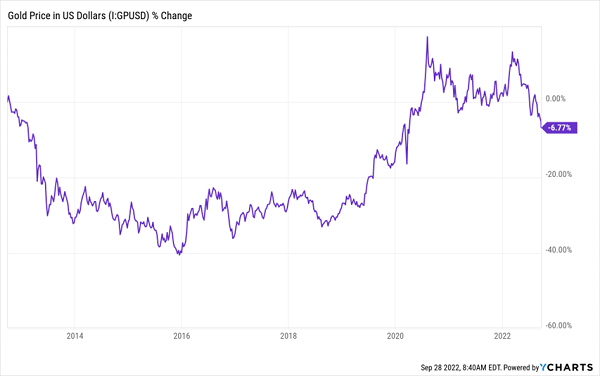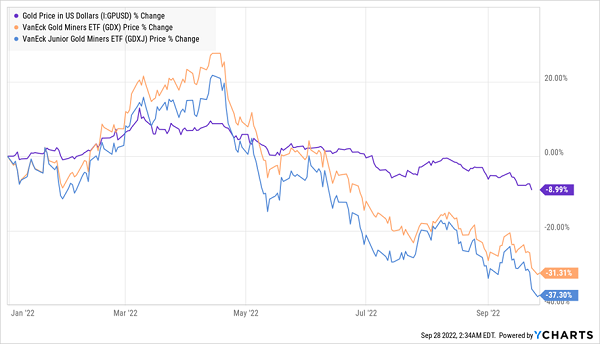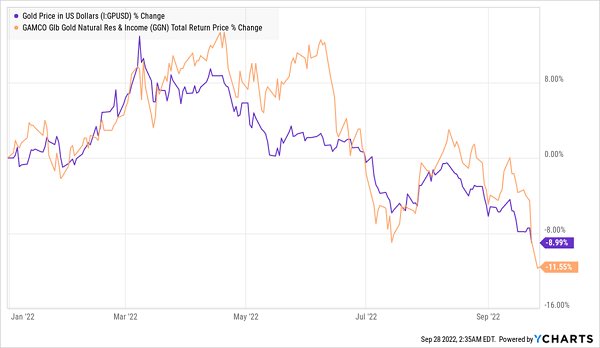For some folks, it’s almost a reflex to buy gold when inflation hits or volatility ramps up. In times like those, they simply flock to the yellow metal—no questions asked.
But buying gold as a safe haven is a terrible idea, for one simple reason: it doesn’t work.
The dumpster fire year we’re living through now provides an excellent example of gold’s ineffectiveness as an inflation hedge: while inflation soared (it sits at 8.3% as of August), gold has gone the other way, plunging 6.4% since January 1.
That lousy performance isn’t just a one-off. Gold has actually fallen 7% in the last decade. In other words, if you’d held it over that time, it would have dragged down your returns.
In other words, it’s pretty much the opposite of a safe haven!
Gold Is the Anti-Inflation (and Volatility) Hedge

And if you’re looking for dividends, gold is an especially poor choice. Gold bars and coins, of course, pay zero dividends and come with costs to store and secure them. ETFs that track gold prices, like the SPDR Gold Shares ETF (GLD) free you from those costs, but you still won’t get an income stream.
The only option for dividend investors, then, is to buy shares of gold miners directly or through ETFs that hold them, like the VanEck Gold Miners ETF (GDX), which holds larger gold firms, and the more exploration-focused VanEck Junior Gold Miners ETF (GDXJ).
Trouble is, their payouts aren’t enough to get our pulses racing, with GDX yielding 2.4% and GDXJ paying 2.8%. The other problem is that holding gold miners is risky, as they’re subject to political uncertainty in countries where they operate mines, poor results from their exploration efforts and other potential pitfalls unique to the industry.
Those factors have certainly weighed on GDX and GDXJ this year, as they’ve fallen way behind the already-disappointing performance of gold itself:
Gold Miners: Not a Lower-Risk Way to Invest in Gold

High-yield closed-end funds (CEFs), which we focus on exclusively in my CEF Insider service, can be another option for investing in gold and collecting a high yield, too. But I don’t hold gold CEFs in the service’s portfolio—and likely never will—for the same reason we saw with gold prices and gold-mining ETFs: lousy performance.
Consider the GAMCO Global Gold Natural Resources and Income Fund (GGN). It sports an outsized 11.7% yield and invests about half of its portfolio in metal and mining companies. While it’s done a lot better than GDX and GDXJ, it’s also underperformed gold and seems to be testing new lows every day.
GGN’s Gold Holdings Weigh It Down

The CEF’s saving grace has been a bit of luck; most of the other half of its portfolio is in energy companies, and those investments have helped prop up the losers. Because of that, you’re far better off skipping gold entirely and investing in a “pure” energy CEF like the Kayne Anderson Nextgen Energy & Infrastructure Fund (KMF), which is up slightly in a year when almost everything is down.
The Energy Pure Play Wins

The takeaway here is pretty clear: gold doesn’t work as investment, particularly for those of us seeking income. Even if you think inflation is going to stay hot for a while, both the last year and the last decade have proven that gold is not a reliable inflation hedge.
My View on Gold: Forget It! And Stick With CEFs Holding Household-Name Stocks
Instead of messing around with gold, you’re best to stick with blue chip US stocks—especially if you buy them through CEFs, which give you most of your yearly return in cash, thanks to their high dividends. The average CEF yields around 7% today.
Consider, for example, a CEF like the Liberty All-Star Growth Fund (ASG). Despite the “Growth” in its name, this one focuses heavily on income, with an 8.9% current yield. ASG holds a mix of midcap stocks, like property-management firm FirstService (FSV), and household-name large caps like Amazon.com (AMZN), UnitedHealth Group (UNH) and Visa (V).
Unlike our gold plays, ASG has delivered a healthy return in the last decade, nearly tripling investors’ money in that time:
ASG Dominates Gold Investments in the Long Run

ASG has a policy of paying out 8% of its net asset value (NAV) as dividends per year, so its dividend does fluctuate a bit, but that policy also ensures the fund has the cash to scoop up bargains during selloffs like this one, which fuels its future growth. ASG’s discount to NAV of 2%, compared to a 52-week average premium of 5%, adds further upside.
5 Monthly Dividend CEFs That Beat Gold, Stocks and Everything Else
ASG is a strong pick for stock exposure, but its constantly shifting payout makes it a less-than-ideal choice for investors who need predictable income.
The good news here is that you can get high CEF dividends like the one ASG pays and regular payouts, too. The 5 CEFs (yielding 7.9% on average) I’ll share with you right here are your best options. Not only do they pay dividends far greater than you’d get from any gold investment, they also pay you every single month, right in line with your bills!
Plus, these 5 funds trade at such unusual discounts that I’m calling for 20% price upside from them in the next 12 months.
I can’t wait to tell you about them. Click here and I’ll give you all of my research on these 5 monthly paying CEFs in an exclusive Special Report.
